Search results for: 'Egyptian'
-
 Small Egyptian Kohl vessel
Small Egyptian Kohl vesselThe stone pot was used for Kohl, the eye cosmetic of the ancient Egyptians. Vessel with well preserved body and missing rim. From the 2nd Millenium BC.
Price: on request Egyptian Eye of Horus
Egyptian Eye of HorusSmall amulet in form of the Eye of Horus. Popular type of protective amulet from Ancient Egypt.
Price: on request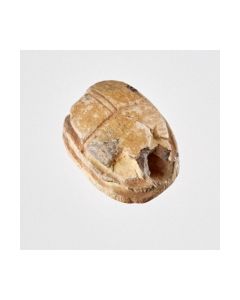 Egyptian Scarab with hieroglyphs
Egyptian Scarab with hieroglyphsInteresting scarab made of steatit with inscription for Amun. Dating to the 19th to 21st dynasty of ancient Egypt.
Price: on request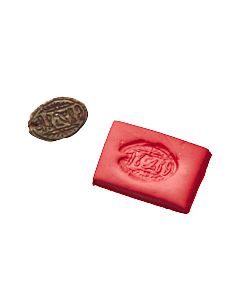 Egyptian cowroid with nice decoration
Egyptian cowroid with nice decorationAmulet seal with pseudo hieroglyphs at the underside that should give protection or good fortune to the owner according to ancient Egyptian beliefs. New Kingdom of ancient Egypt.
Price: on request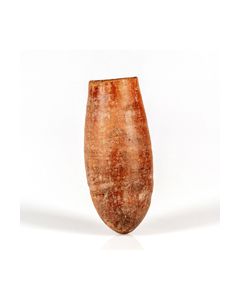 Egyptian predynastic redware jar
Egyptian predynastic redware jarSimple pottery vessel of timeless elegance. From the Naqada I period, 4th Millenium BC.
Price: on request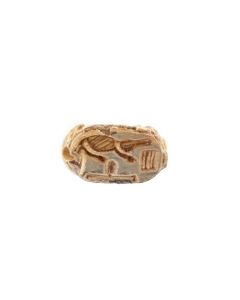 Egyptian scarab for Sobekhotep
Egyptian scarab for SobekhotepThe back of the scarboid body is shaped like a lying cat. New Kingdom of ancient Egypt, around 1000 BC.
Price: on request Egyptian cowroid with protective function
Egyptian cowroid with protective functionAmulet seal with pseudo hieroglyphs at the underside that should give protection or good luck to the owner according to ancient Egyptian beliefs. Second Intermediate Period of ancient Egypt.
Price: on request Egyptian predynastic cosmetic palette
Egyptian predynastic cosmetic paletteHigh quality palette with two stylized bird heads. Characteristic for the Naqada II period. Circa 3500 to 3200 BC.
Price: on request Egyptian scarab with crocodiles
Egyptian scarab with crocodilesAmulet seal from Thebes with depiction of Sobek. From the 18th to 20th dynasty of ancient Egypt.
Price: on request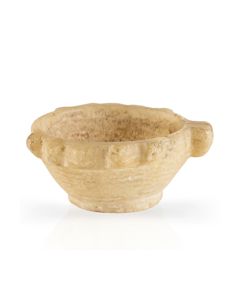 Egyptian alabaster bowl from Luxor
Egyptian alabaster bowl from LuxorThe small stone vessel is an offering bowl for libation. From the collection of Egyptologist Professor Wiedemann. 12th to 18th dynasty of Ancient Egypt
Price: on request Egyptian ushabti for Viceroy Hori
Egyptian ushabti for Viceroy HoriOne of only 30 known funerary statuettes from the tomb of Hori I, King's son of Kush. Viceroy of Kush in Nubia during the reign of the pharaohs Ramesses III and IV. An exhibited and repeatedly published piece.
€8,850 Egyptian stone vessel from Luxor
Egyptian stone vessel from LuxorThe cosmetic vessel is of a rare type. From the collection of Egyptologist Professor Wiedemann. Middle Kingdom of Ancient Egypt
Price: on request Egyptian cowroid with knot design
Egyptian cowroid with knot designAmulet seal with interesting design at the underside that might represent the unity of Egypt. Second Intermediate Period of ancient Egypt.
Price: on request Egyptian cowroid with pseudo hieroglyphs
Egyptian cowroid with pseudo hieroglyphsAmulet seal with papyrus trees and other signs on the bottom side. Second Intermediate Period of ancient Egypt.
Price: on request Egyptian scarab with knot design
Egyptian scarab with knot designAmulet seal with complex knot design at the underside. Second Intermediate Period of ancient Egypt.
Price: on request Egyptian scarab with cross design
Egyptian scarab with cross designAmulet seal with complex design of crosses on the underside. Second Intermediate Period of ancient Egypt.
Price: on request Egyptian scarab with spiral design
Egyptian scarab with spiral designAmulet seal in the shape of a scarab with schematic top side. Second Intermediate Period of ancient Egypt.
Price: on request Egyptian scarab with knot design
Egyptian scarab with knot designAmulet seal with a complex knot design on the underside, possibly symbolizing the unity of Egypt. Second Intermediate Period of ancient Egypt.
Price: on request Egyptian scarab with spiral design
Egyptian scarab with spiral designAmulet seal in the shape of a scarab with schematic top side. Second Intermediate Period of ancient Egypt.
Price: on request Egyptian cowroid with knot design
Egyptian cowroid with knot designAmulet seal with interesting top side markings. Second Intermediate Period of ancient Egypt.
Price: on request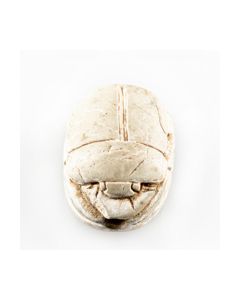 Egyptian scarab with curl design
Egyptian scarab with curl designAmulet seal in the shape of a scarab with schematic top side. Second Intermediate Period of ancient Egypt.
Price: on request Egyptian faience figurine of Sekhmet
Egyptian faience figurine of SekhmetProtective amulet in the form of a statuette of the lion-headed goddess with a hieroglyphic inscription on the back. A wonderful and large faience from the Third Intermediate Period of Ancient Egypt.
Price: on request Egyptian funerary cone of Amunemopet
Egyptian funerary cone of AmunemopetConoid clay nail from the tomb of crown prince Amunemopet. From Thebes during the 18th dynasty. New Kingdom of ancient Egypt.
Price: on request Egyptian scarab with papyrus plants
Egyptian scarab with papyrus plantsScarab amulet made of bright, almost white steatite. 13th to 15th dynasty. This scarab is described in the catalogue of Irène Gautier-Vodoz.
Price: on request Egyptian Scarab with sun beetle
Egyptian Scarab with sun beetleThe scarab amulet from Ramesside times has a beetle engraved in the lower side, flanked by two symbols.
Price: on request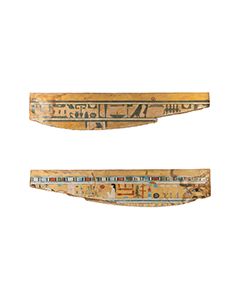 Fragments of an Egyptian coffin lid
Fragments of an Egyptian coffin lidMagnificently preserved, polychrome hieroglyphs from the 12th Dynasty. A prime example of the strict yet energetic art of the Middle Kingdom. With attribution by Professor Settgast of the Egyptian Museum in Berlin from 1979.
€26,400 Egyptian funerary figurine for Nefer-hotep
Egyptian funerary figurine for Nefer-hotepInteresting ushabti from Memphis dating to the late 19th Dynasty, New Kingdom. The owner was an official from the Temple of Ptah.
Price: on request Egyptian scarab as a protective amulet
Egyptian scarab as a protective amuletAmulet seal in the shape of a scarab with schematic top side and pseudo hieroglyphs at the underside. Second Intermediate Period of ancient Egypt.
Price: on request Large Egyptian Shabti made of Alabaster
Large Egyptian Shabti made of AlabasterStunning funerary statuette from the 19th dynasty of Ancient Egypt. Marvelous provenance and publications in numerous catalogues.
Price: on request Egyptian scarab with interesting stamp design
Egyptian scarab with interesting stamp designAmulet seal with a complex knot design on the underside, possibly symbolizing the unity of Egypt. Second Intermediate Period of ancient Egypt.
Price: on request Egyptian Eye of Horus, New Kingdom
Egyptian Eye of Horus, New KingdomSmall amulet in form of the Eye of Horus. Popular type of protective amulet from Ancient Egypt.
Price: on request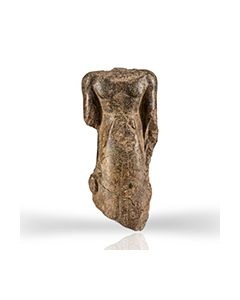 Torso of an Egyptian striding figure
Torso of an Egyptian striding figureAn elaborate, small private portrait from the Middle Kingdom of Ancient Egypt. Made from beautifully textured granodiorite. With certificate from 1975.
€8,800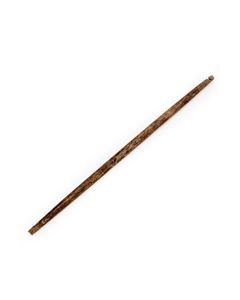 Egyptian spindle shaft made of wood
Egyptian spindle shaft made of woodExceptionally rare main piece of a hand spindle. A find from Thebes in Upper Egypt. From the reign of pharao Senusret II, around 1840 BC.
Price: on request Egyptian palette of the Middle Kingdom
Egyptian palette of the Middle KingdomWorkpiece of an artisan for grinding materials. A very similar grinding palette was found in Abydos. From the inventory of the Falmouth Museum.
Price: on request Egyptian fingerring from the Amarna period
Egyptian fingerring from the Amarna periodMade of colourful turquoise fayence. Two fully modelled crocodiles adorn the plate. Perfect preservation including original black paint.
Price: on request Egyptian faience ring showing Bes and Taweret
Egyptian faience ring showing Bes and TaweretThe finger ring with its scene on the plate must have served a protective function for an expectant mother. New Kingdom, approx. 1550 to 1070 BC.
Price: on request

